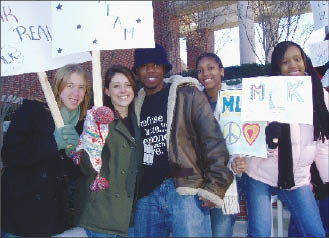Oasis Center
Nashville, Tenn.
(615) 327-4455
http://www.oasiscenter.org
Objective: To help disadvantaged youth in the Nashville community move past their problems and develop leadership skills.
 |
|
FROM AT-RISK TO IN CONTROL: Oasis Center uses civic engagement activities, such as public demonstrations, to help youths emerge as leaders. Photo: Photo courtesy of Oasis Center |
In a Nutshell: Oasis Center was founded in 1969 by a group of neighbors to assist young people who were experiencing some of the negative side effects of the 1960s social and cultural upheavals. It now operates 13 different initiatives encompassing crisis intervention, assistance to youth who have run away or are homeless, school-based prevention services, and opportunities for youth to volunteer and lead. The four primary programs are its crisis services, transitional living for homeless or foster youth, family and youth counseling, and leadership development.
Where and When it Happens: The center is based in Nashville, and operates programs that range in frequency from daily to weekly.
Who Started It and Who Runs It: Oasis Center is lead by CEO Hal Cato; its 13 programs are staffed by 44 salaried and 36 hourly staff members. Last year, more than 475 people volunteered for the organization.
Obstacles: “Setting up an evaluation process that measures and determines the value of Oasis Center’s philosophy and approach has been a problem, and is one we continue addressing today,” Cato says. “While most youth programs track data that reflects a decrease in negative behaviors, that data doesn’t reflect a young person’s well-being or sense of connectedness.”
Oasis developed its own methodologies and database to track progress in four impact areas: youth being safe; youth being connected with caring adults; finding opportunities to participate; and promoting the concepts of generosity and justice. The database is being tested and will launch this spring.
Cost: The yearly operating budget for Oasis is $3,022,000.
Who Pays: Funding comes primarily from federal grants (17 percent), state and local grants (29 percent), and private foundations and individuals (32 percent). Foundation supporters include the Mary Reynolds Babcock, W.K. Kellogg and Frist foundations.
Youth Served: The majority of youth come from metropolitan Nashville and surrounding counties, although there are no geographical boundaries to the services. Services are primarily available to youth ages 13 to 17, but that age range is extended to 21 in the case of homeless youth. The youths’ demographic breakdown (about 35 percent white, 35 percent African-American, 6 percent Hispanic and the rest “other”) roughly mirrors the city’s overall mix. About three-quarters of the youth come from low-income families.
Youth Turn-On: Potential clients hear about Oasis “mostly from peers,” Cato says. “That we’re using youth as our key spokesmen is a big turn-on. They see our kids leading in a big way and say, ‘I can do that.’ ”
Youth Turn-Off: “Changes in staffing can be hard for youth to accept, especially if the new staff person doesn’t live up to their expectations in some area,” Cato says.
Research Shows: While the evaluation remains in its testing phase, Oasis has garnered attention for some accomplishments. For example, one of the two high schools it serves credited the nonprofit with helping to double the number of seniors accepted into college in 2006. Oasis Center was named this year’s agency of the year by the National Network for Youth.
What Still Gets in the Way: Many youth have to travel a modest distance to the program. “Since Nashville has a limited public transportation system,” Cato says, “this is a barrier for many youth.”
























